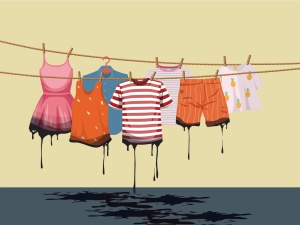Licence to Greenwash: How certification schemes and voluntary initiatives are fuelling fossil fashion

Executive summary
The fashion sector is awash with certification schemes, sustainability labels and multi-stakeholder initiatives all seeking to steer the industry onto a greener course. As public and political awareness of the high environmental and social toll of the fashion industry has climbed the agenda, and scrutiny on brands has intensified, so has the visibility of certification schemes and voluntary initiatives pitched as holding the solutions.
The existence of such schemes serves a dual purpose for the brands. As the fashion industry is one of the least regulated sectors in the world, these schemes partially exist as a genuine attempt to move towards sustainability in the absence of environmental legislation. But they also enable the proliferation of ‘greenwashing’ on a remarkable scale. Whether it is the use of certification labels on individual products – assuring customers that they can shop guilt free by putting their money where their values lie – or brands proudly communicating their membership of various fashion-related voluntary initiatives, the existence of these schemes and the inherent lack of accountability within them are a key part of the greenwashing machinery of the modern fashion industry. Moreover, the level of influence exercised by fashion brands in these initiatives and the lack of any independent oversight, inevitably means that they end up promoting industry interests.
Reading the progress or sustainability reports of the majority of initiatives and brands alone would have you believe that we are just one label or initiative away from the total transformation of the fashion industry into a dreamscape of circularity and eco-design. Yet, beyond the greenwash, the unsustainable trajectory of the modern fashion industry is alarming. Over the past 20 years, the number of garments purchased per consumer has more than doubled and it is projected that overall apparel consumption will rise by 63%, from 62 million tonnes today to 102 million tonnes by 2030. At the same time, clothing utilisation – i.e. the number of times a garment is used before being discarded – has declined by almost 40% over the past 15 years. These trends are driven by the sector’s heavy reliance on cheap synthetic fibres, which now represent more than two-thirds of all materials used in textiles and have enabled exponential growth of cheap clothing consumption over the last two decades. The globalised nature of fashion’s supply chains is often represented as a challenge for the introduction of mandatory measures, but – as this report will demonstrate – self-regulation in the form of certification or voluntary initiatives has failed.
Of more than 100 sustainability certification schemes in use in the textile industry and listed in the Ecolabel Index, this report by the Changing Markets Foundation provides a qualitative analysis of the best-known initiatives, with a focus on those that claim to address issues of circularity, overproduction and the rise of fast fashion, end-of-life management and the elimination of toxic chemicals from production or manufacturing. Of the ten initiatives analysed, several are certification labels (bluesign®, Cradle to Cradle (C2C), EU Ecolabel, OEKO-TEX® and Textile Exchange’s Global Recycled Standard and Recycled Claim Standard), others are multi-stakeholder initiatives (the Ellen MacArthur Foundation (EMF), The Microfibre Consortium (TMC) and ZDHC) and others provide a set of self-assessment tools (the Higg Index and WRAP) for the industry to measure their sustainability. What these schemes have in common are that they is all voluntary and enjoy high levels of industry buy-in and cross promotion.
You might also like...

Trashion: The stealth export of waste plastic clothes to Kenya
This report shows that the amount of second-hand clothing flowing to Kenya from global sources has grown significantly in recent years and the system of used-clothing trade is currently at breaking point.

Dressed to Kill: Fashion brands’ hidden links to Russian oil in a time of war
This report exposes the hidden supply chain links between major global fashion brands and retailers and Russian oil used to make synthetic clothing.

Fossil fashion: the hidden reliance of fast fashion on fossil fuels
This report reveals the hidden reliance of the fast fashion industry on fossil fuels. It also uncovers how the oil and gas industry are betting on production of plastic as a growing share of their revenue.